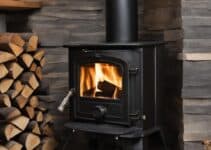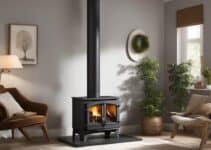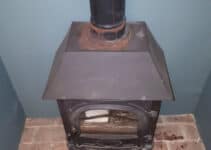As an enthusiast of wood-burning stoves, I’ve followed the evolution of air control technology with keen interest. Deciding whether a log burner with manual air controls or one equipped with automatic air controls better suits one’s lifestyle, is a topic that I’ve often mulled over. The intricate art of how to control air in a log burner stands as a hallmark of traditional heating practices. Yet, as times change, so does the canvas of choice, broadening our options to modern convenience with the upsurge of manual vs automatic log burners.
My journey has brought me face-to-face with the raw, tactile control of manual air adjustments, where the flicker of flames dances to the tune of experience and intuition. But it’s impossible to overlook the seamless ease that accompanies log burners with automatic air controls, revolutionising the way we maintain our hearths. In this discourse, I delve into the intricacies of both sides, unearthing the merits that tailor to varied predilections, whether it be hands-on mastery or the effortless grace of automation in stoking the fires of warmth within our homes.
The Evolution of Air Control Technology in Wood Stoves
As I delve into the intricacies of wood stove technologies, it’s clear that the journey from manual to automatic air controls is not just a leap in convenience, but a reflection of the historical development of log burner technology. This transition is much like a vibrant narrative, unfolding across decades, illustrating the human desire for warmth, efficiency, and effortless operation. There’s an undeniable charm in the tactile interaction with manual air controls, yet the lure of automation carries the promise of optimised combustion and a hands-free approach to heat regulation.
From Manual to Automatic: A Historical Perspective
The affection for log burners with manual air controls stems from a deep-rooted tradition of crafting fire with our own hands, a skill passed through generations. Acknowledging the slow-moving yet irreversible shift towards automatic air controls for log burners, it’s essential to evaluate the benefits of manual vs automatic air controls. The former offers manual engagement, while the latter boasts of providing consistent home comfort with minimal effort.
Historically, maintaining a log burner was almost an art form, demanding vigilant adjustment of the air intake to sustain the perfect flame. The modern transition from manual to automatic air controls speaks volumes about our advancement in understanding the combustion air flow mechanics and our aspirations to finely tune our living environments with technological assistance.
Understanding the Mechanics of Airflow in Combustion
I recognise that the heart of a log burner’s performance lies within its ability to manage combustion effectively. By understanding the log burner combustion process, we are able to enhance stove designs for improved efficiency and emissions. Precise air controls for log burners are pivotal, and the Scandinavian approach has been at the forefront of integrating stages of air to maximise the volatile matter conversion.
Industry-leading automated control systems now embody this depth of understanding, utilising temperature and oxygen sensors to regulate the airflow dynamically. This sophisticated control represents more than convenience; it ensures the stove operates within ideal parameters, mitigating the environmental impact and setting new standards in eco-friendly heating solutions.
The data-driven approach of these air control systems highlights the bridge we’ve crossed from the days of haphazard guesswork to eagle-eyed precision in managing our fires. As I look towards the future of wood stove technology, it’s evident that this evolution will only continue in its momentum, aiming to provide households with an eco-conscious choice that doesn’t compromise on warmth and well-being.
Manual vs Automatic Air Controls Log Burner: A Comparison
When deliberating on choosing between manual and automatic air controls for log burners, I recognise the importance of considering key factors such as user engagement, efficiency, and ultimately, the environmental impact. This comparison draws upon my personal experiences as well as extensive knowledge in the field of wood-burning stoves and their technological advancements.
- Manual air controls allow for a granular level of control, where the user can manipulate the air intake to affect the combustion process directly.
- Automatic air controls, by contrast, use sensors and algorithms to adjust the air flow, simplifying the process for the user and potentially improving the stove’s overall efficiency.
My interest lies not only in the experience but also in the practical outcomes. Thus, the log burner air control comparison is extended to an analysis of their impacts on emissions—a topic of considerable significance, particularly in countries stringent about environmental regulations.
Comparing manual vs automatic air controls log burner systems becomes a dialogue between tradition and innovation, between direct involvement and automation.
The allure of manual controls in the hands of an adept user can lead to sublime moments where the flames are coaxed and nurtured to produce just the right amount of warmth. Conversely, automatic controls, with their precision and reliability, can effortlessly maintain a consistent burn, which translates into steady heat output and lower emissions—a boon for both the user and the environment.
| Attribute | Manual Air Controls | Automatic Air Controls |
|---|---|---|
| User Engagement | High, with direct manipulation of the air intake | Low, automation takes charge of adjustments |
| Efficiency | Varies with user’s skill and experience | Optimised by real-time air flow adjustments |
| Emission Impact | Dependent on correct user adjustments | Potentially lower due to precise combustion control |
Thus, it’s clear that the choice is not purely binary; it involves a nuanced understanding of one’s preferences and requirements. Whether you’re an individual appreciating the methodology of a manual system or someone who seeks the ease of an automatic, both speak to diverse needs and lifestyles.
Benefits of Manual Air Controls in Log Burners
The enduring allure of traditional wood stoves has remained steadfast in a world drifting towards automation. At the core of this persistence is the appeal of manual air controls, a feature that allows users to interact intimately with their log burners. This robust, hands-on control of log burners facilitates a level of engagement that is both rich and rewarding, highlighting the manual log burner user experience.
The Appeal of Hands-On Operation
There’s an undeniable charm in igniting and nurturing a fire through one’s own efforts. Adjusting the air supply manually grants a satisfying command over the flame and heat output. For me, the bespoke log burner combustion enabled by these manual adjustments is not just a matter of heating a room; it’s a personal involvement that opens up a sensory dialogue with the natural element of fire.
Customisation and Control for Experienced Users
Seasoned wood stove aficionados often prefer the customisation of air intake in log burners. Every fuel load, whether it’s hardwood or softwood, demands a unique air supply for optimal combustion. The capacity to finely tune these settings with manual air controls not only maximises the stove’s efficiency but also extends the longevity of the burn, culminating in an exemplary heating solution tailored to one’s individual needs. It’s a process that puts the control firmly in my hands, offering an unparalleled sense of autonomy.
| Feature | Advantages | User Experience |
|---|---|---|
| Personalised Control | Ability to tailor fire intensity and burn rate | A more involved and gratifying interaction |
| Direct Air Manipulation | Instantaneous response to changes in airflow | Real-time adaptability to fuel and environment |
| Skill-Based Operation | Enhances knowledge of combustion principles | A rewarding challenge for the enthusiast |
For me, the marriage of knowledge and skill that comes with using these manual air controls for experienced users transforms every instance of fire lighting into a nuanced ritual of precision. Every crackle of the flame, every whisper of airflow, becomes a testament to the enduring allure of a well-harnessed hearth.
Advantages of Automatic Air Controls for Log Burners
The integration of automatic air controls within log burners has revolutionised the way we experience warmth and comfort in our homes. Not only does it herald a new era of convenience, but it also amplifies the efficiency and eco-friendliness of domestic heating technologies. Delving into the merits of these innovations, it’s clear that the technological advancements in log burners are shaping a future where convenience and environmental responsibility converge.
User Convenience and Consistent Combustion
Reliability and user-friendliness are at the heart of the latest automatic air controls convenience, ensuring that anyone can comfortably manage their log burner to achieve the necessary heat. No longer is there a need to decipher the complex nuances of manual adjustments. This automation stands as a testament to user-friendly log burner technology, offering a seamless and effortless heating experience. Furthermore, consistent combustion with automatic controls culminates in a more efficient and reliable heating cycle, markedly improving the quality of heat distribution within the space.
Technological Innovations Leading to Enhanced Efficiency
When we speak of modern log burner advancements, we are referring to the precision that technological innovations in log burners bring to the table. These smart systems take into account real-time variations in temperature and burning conditions, making on-the-fly adjustments to air flow. The enhanced efficiency with automatic controls means log burners are no longer voracious for fuel, but rather meticulous in their consumption, leading to reduced operational costs and a lighter carbon footprint.
Reductions in Emissions: Environmental Considerations
In the face of rising environmental concerns, the ability of automatic air controls to curtail emissions is a point of significant importance. By providing uniform and complete combustion of logs, these sophisticated systems play a pivotal role in log burner emissions reduction. The goal is for Eco-friendly log burner technology to be the norm, not the exception, aiding in the vast reduction of pollutants released into our atmosphere, making our reliance on wood as a source of warmth not just economical, but also environmentally considerate.
In addressing environmental considerations for air controls, it becomes evident that these technological strides are indispensable in our journey towards sustainability. It’s a marriage of comfort and conscience, allowing us to indulge in the primal comfort of fire, mindful of our ecological impact.
Conclusion
In my assessment, the debate surrounding manual vs automatic air controls in wood stoves draws upon one’s penchant for either an engaged experience or a seamless one. Those who favour the former thrive on the customisability and direct interaction that manual controls provide. It’s a hands-on approach that empowers users to fine-tune their log burners, immersing them in the artisanal aspect of heat management. However, weighing the benefits of manual vs automatic air controls, one cannot overlook the latter’s contribution towards an efficient and environmentally considerate future.
Automatic air controls, by contrast, appeal to a different set of priorities, embodying ease of use and technological sophistication. They represent a step toward sustainability, operational ease, and consistency—attributes that chime well with our modern lifestyle. The eco-centric design inherent in these systems aligns with an increasing environmental awareness, ensuring optimised fuel efficiency and reduced emissions. As technology progresses, I foresee an inclination amongst manufacturers and users alike towards log burner air control options that embody intelligent automation.
In conclusion, the dialogue on manual vs automatic air controls in wood stoves culminates in a recognition of diverse needs and the evolution of heating technologies. Each control type serves its purpose and audience, depending on individual circumstances and values. And while manual controls will always have their aficionados, the emergence of automatic controls heralds a new era—one where convenience and eco-friendliness are paramount. Thus, the burgeoning trend is likely to veer towards automatic systems, which foster a sustainable and effortless user experience.



